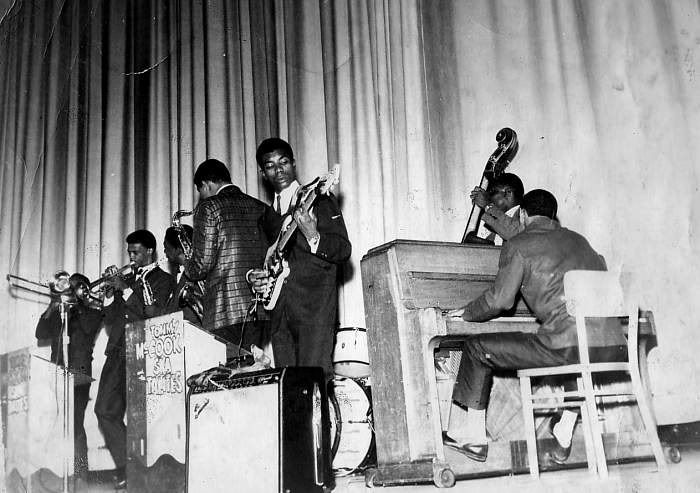
When ska began its change into the more sophisticated-sounding Rock Steady during 1966-'67 singers came into their own. While the tempo remained about the same Rock Steady carried a relaxed rhythmic density.
In Rock Steady the guitar only strums on beats 2 & 4, and the bass guitar emphasizes beats 1 & 3.
Drums are less prominent in Rock Steady as their rhythmic role was being taken over by the bass guitar. Drums provided accents, or were inaudible. Less predominant horns and less-rigid beat offered more vocal possibilities. Rock Steady was perfect for romantic group vocals.
The Birth Of Rocksteady.
Ska desperately needed to move on. By the summer of 1966 it had been around for more than half a decade, and while the songs had grown in sophistication, the basic rhythm and arrangements hadn't. There was still the defining off-beat emphasis over a walking bass pattern. The rock steady concept brought the new idea ska sought.
The rhythm was experimented with," noted Barrow, "and it was slowed down because of what was happening with the rude boys in the dancehalls. Roy Shirley says he made "Hold Them" in 1965. He could have done it as a slow rhythm, but I don't think it was rock steady. Hopeton Lewis went in to do a ska tune, "Take It Easy," and he couldn't manage it on the rhythm, so he said to play it slow. They played it half-speed, and when it was done, someone said to him, 'That rock steady, man, that's rockin' steady.' And that's how the name came about. He claims he was before Studio One, Beverley's, everyone with rock steady (the record was released on Federal)."
"Although ska had flared briefly in England, the flame didn't take full hold until rock steady hit."
That's one version of the history, and perhaps more likely than some others. The advent of rock steady has also been attributed to an extremely hot summer, which forced all the dancers to move more slowly - to rock, instead of move wildly - and that was reflected in the new sides appearing. It's also been said the sound came from musicians' dissatisfaction with the ska beat, and the search for something new. Whatever the true reason, it was decidedly different from ska.
"It broke up the rhythm," explained Barrow. "It had the effect of making the bass play in clusters, a pattern, rather than a continuous line. The drums and everything fell in with that. [Guitarist] Lynn Taitt was the guy who orchestrated that. Not enough people mention him. He was one of the great unsung heroes of Jamaican music, and he was a Trinidadian." Inevitably, the new rhythm proved very popular ("Take It Easy" sold 10,000 copies in a single weekend) party because it was new, and also because dancers didn't have to expend so much energy and could stay on the floor longer.
Whereas Coxsone Dodd and his Studio One label had dominated ska, it now became Duke Reid's turn in the pole position, as Treasure Isle quickly established itself as the home of the new sound. He took Alton Ellis from Dodd, to add to his stable, which included the Paragons and Dobby Dobson, all backed by a new studio band, the Supersonics, led by Tommy McCook. After the 1964 breakup of the Skatalites, McCook recalled, "Coxsone formed the Soul Vendors, and I was asked to lead it. I said I didn't want to right then, I needed some rest after being under pressure. About a couple of weeks later I did say okay, and renamed the band the supersonics. All I had to do was play music and rehearse the band, unlike the Skatalites, where I'd had to do everything. We had a steady weekly gig, they were playing salaries, and that made it easier. Then we became a Treasure Isle recording group. A lot of the pressure was off me, and we were doing pretty good."
Among the vocal groups they backed for Reid were the Techniques, one of the best of the era. With hits like "Queen Majesty" and "Love Is Not A Gamble" they were a major force, and a training ground for a number of singers who'd progress to solo careers, like Slim Smith and Lloyd Parks, who worked with the core of Winston Riley and Frederick Waite. But the change hadn't edged Prince Buster out of the picture. Having scored hits himselfduring the time of ska, as well as being one of its leading producers, he continued to release material, with "Judge Dread" in particular becoming huge, its castigation of the Rude boy style triggering a number of like-minded songs from other artists.
The tunes on this compilation were recorded between the end of 1965 And early 1968 to show you the transistion from Blue Beat To Rock Steady To Early Reggae. The recording band are The Soul Vendors, musical producer is sir Coxsone, so get ready let's do rock steady.
the tracklist is in the comment.
Download link:
http://rapidshare.com/files/492139/Rock_Steady_Scorchers.zip.html
 Here is the Jamaican Ska version of Xavier Cugat's "Take It Easy" performed by The Skatalites, recorded for Duke Reid's Treasure Isle Label. Check it out.
Here is the Jamaican Ska version of Xavier Cugat's "Take It Easy" performed by The Skatalites, recorded for Duke Reid's Treasure Isle Label. Check it out.



